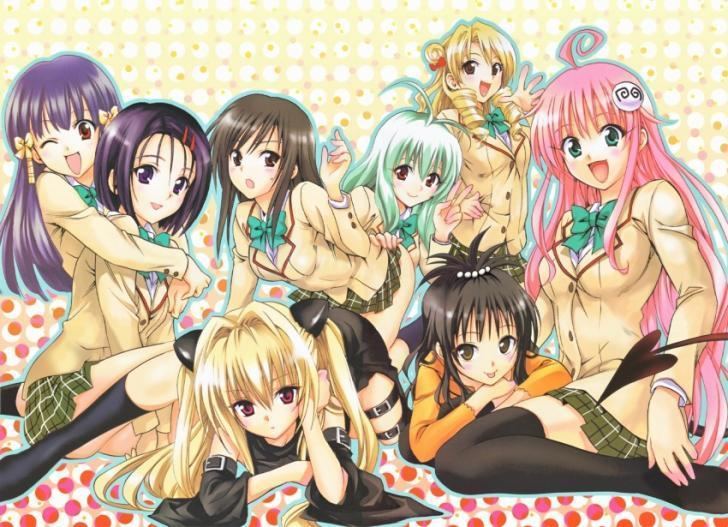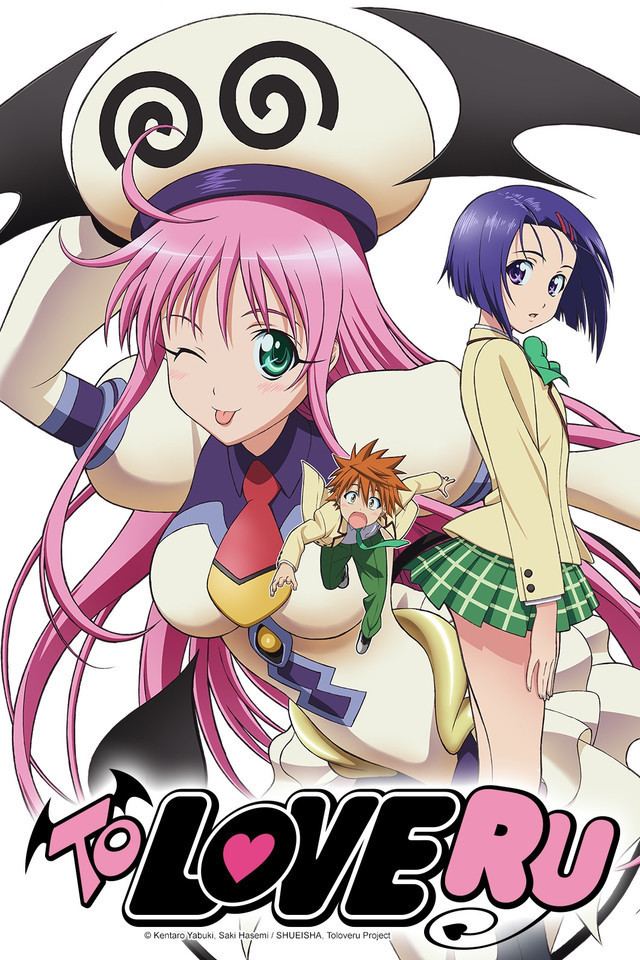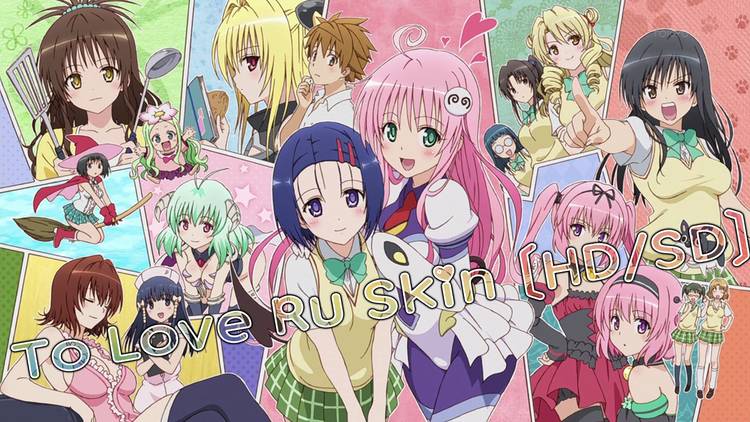Written by Saki Hasemi Published by Shueisha Imprint Jump Comics Adaptations To Love-Ru (2008) | Illustrated by Kentaro Yabuki Demographic Shōnen Studio Xebec | |
 | ||
Original run April 24, 2006 – August 31, 2009 Genres Harem, Romantic comedy, Science Fiction Magazine Weekly Shōnen Jump, Jump Square Similar Kissxsis, Nisekoi, Heaven's Lost Property, Monster Musume, K‑On! | ||
To Love-Ru (Japanese: To LOVEる -とらぶる-, Hepburn: To LOVEru -Toraburu-) is a Japanese manga series written by Saki Hasemi and illustrated by Kentaro Yabuki, creator of Black Cat. The manga was serialized in Shueisha's Weekly Shōnen Jump magazine between April 24, 2006 and August 31, 2009, and the chapters collected into 18 tankōbon volumes. The manga series' title, とらぶる (Toraburu), is the English gairaigo (loan word) "trouble" and "rabu" (ラブ) is the English loan word "love". The title is a pun on the words "love trouble", which describes the harem aspect of the series.
Contents

A drama CD was released in February 2008 with an original story. A 26-episode anime series adaptation by Xebec aired in Japan between April and September 2008. Six original video animation episodes were produced by Xebec between April 2009 and April 2010. A 12-episode second season by Xebec titled Motto To-Love Ru aired between October and December 2010. Four video games have been released for the Nintendo DS, PlayStation Portable and PlayStation Vita.

A continuation of the manga called To Love-Ru Darkness (To LOVEる -とらぶる- ダークネス, To LOVEru -Toraburu- -Dākunesu-) began serialization in Shueisha's Jump Square magazine on October 4, 2010 and ended on March 4, 2017. Xebec produced four OVA episodes of To-Love Ru Darkness and later an anime television series adaptation that aired between October and December 2012. A second season of To-Love Ru Darkness, called To Love-Ru Darkness 2nd, aired between July and October 2015.

Should you watch to love ru series
Plot

The story of To Love-Ru revolves around Rito Yūki, a shy and clumsy high-school student who cannot confess his love to the girl of his dreams, Haruna Sairenji. One day when sulking in the bathtub, a mysterious, naked devil-tailed girl appears out of nowhere. Her name is Lala, the runaway crown princess of the planet Deviluke. Her father wants her to return home to marry one of her marriage candidates. When Devilukean commander Zastin arrives to bring her home, she swiftly declares she will marry Rito in order to stay on Earth, leading Zastin to attack Rito. But when Rito angrily declares that marriage is only possible with the person you love, the two dull-witted aliens misunderstand him, believing he truly understands Lala's feelings. Lala quickly falls in love with him, and Zastin also approves of their engagement, much to Rito's dismay. While Zastin reports his support for the pair to Lala's father, the King of Deviluke and much of the known universe, Rito reluctantly helps Lala transition to life on Earth, while gradually befriending his dream girl, Haruna, along with a colorful cast of other girls, both humans and aliens. In the meantime, Rito must also fight off Lala's antagonistic alien suitors, one of whom sends the alien assassin, Golden Darkness (also known as Yami) to kill him.
The story continues in To Love-Ru Darkness, which focuses on Lala's little sister, Momo. The twin sisters, Nana and Momo, have since come to live with Lala in Rito's house. While Rito remains indecisive between his longtime crush on Haruna, and his growing affection for Lala, Momo has also fallen in love with Rito. But not wanting to steal Rito away from her sister, Momo instead plots to build a harem of girls around Rito, hoping that if Rito marries Lala and becomes king of Deviluke, he can legally marry every girl who is in love with him, including Momo herself. While Momo works in the background and plays matchmaker with Rito, a plethora of beautiful girls gradually enter Rito's life and warm up to his kindness, including Golden Darkness, who has since lived peacefully on Earth but struggles to escape her dark past. Thus, Rito's otherworldly love troubles continue.
Manga
To Love-Ru began as a manga series written by Saki Hasemi with illustrations by Kentaro Yabuki. It was serialized in Shueisha's manga magazine Weekly Shōnen Jump between April 24, 2006 and August 31, 2009. The chapters were collected into eighteen tankōbon volumes were published by Shueisha in Japan between November 11, 2006 and April 2, 2010. A sequel manga named To Love-Ru Darkness was serialized between October 4, 2010 and March 4, 2017 in Jump Square. The first volume for Darkness was released on March 4, 2011, and 17 volumes have been published as of December 19, 2016. The 18th and final volume will be released on April 4, 2017. Additionally, two bonus chapters are planned for the May and June 2017 issues of Jump Square.
Drama CD
A drama CD for To Love-Ru was released on February 29, 2008 with an original story, featuring the voice cast later used in the anime, along with character songs.
Anime
An anime series adaptation produced by Xebec and directed by Takao Kato aired in Japan between April 3 and September 25, 2008, and contains twenty-six episodes. The anime uses characters and general themes from the original manga, it captures various chapters and events from the manga in no specific order. The anime's opening theme is "Forever We Can Make It!" by Thyme, the first ending theme for episodes one through thirteen is "Lucky Tune" (ラッキーチューン, Rakkī Chūn), and the second ending theme is "Kiss no Yukue" (kiss の行方); both are sung by Anna. The anime is licensed in North America by Sentai Filmworks and distributed by Section23 Films. The complete collection part one containing the first half-season was released on December 15, 2009. Following the release of part two on February 16, 2010, the series began playing on the Anime Network in March 2010. Sentai released the series on Blu-ray Disc in March 2014.
Three original video animation (OVA) episodes produced by Xebec and directed by Takao Kato were shipped starting on April 3, 2009 with pre-ordered copies of the manga's 13th, 14th and 15th volumes. An additional three OVA episodes were released with the bundled version of the 16th, 17th and 18th volumes. The opening theme for the OVAs is "Yatte Koi Daisuki" and the ending theme is "Apple panic"; both songs are by Haruka Tomatsu and Sayuri Yahagi. A second season of the anime titled Motto To Love-Ru (もっとTo LOVEる -とらぶる-) produced by Xebec and directed by Atsushi Ootsuki aired 12 episodes between October 6 and December 21, 2010. The opening theme for the second season is "Loop-the-Loop" by Kotoko and the ending theme is "Baby Baby Love" by Tomatsu. Sentai Filmworks have also licensed the second season and released the complete series set on DVD on April 3, 2012; the Blu-ray set was released on May 27, 2014.
Five OVA episodes of To Love-Ru Darkness were produced by Xebec and released with the limited editions of the manga's 5th, 6th, 8th and 9th volumes on DVD on August 17, 2012, December 19, 2012, August 19, 2013, and December 4, 2013, respectively. A twelve-episode anime television series adaptation was also produced by Xebec and directed by Atsushi Ootsuki. The opening theme for To Love-Ru Darkness is "Rakuen Project" (楽園PROJECT) by Ray and the ending theme is "Foul Play ni Kurari" (ファールプレーにくらり) by Kanon Wakeshima. Sentai Filmworks released To Love-Ru Darkness on DVD and Blu-ray in North America on July 15, 2014. A second season of To-Love Ru Darkness, called To Love-Ru Darkness 2nd aired in Japan between July 6 and October 28, 2015. The opening theme is "secret arms" by Ray while the ending theme is "Gardens" by Mami Kawada. Three OVA episodes of To-Love Ru Darkness 2nd were produced by Xebec between January 4 and December 2, 2016. A fourth OVA episode to commemorate the 10th anniversary of To Love-Ru will be released on August 4, 2017.
Video games
Five To Love-Ru video games have been released. The first is a 2D and 3D visual novel on the Nintendo DS entitled To Love-Ru: Exciting Outdoor School Version (To LOVEる-とらぶる- ワクワク! 林間学校編, To Love-Ru -Toraburu- Waku Waku! Rinkangakkō-hen) which was released on August 28, 2008. The second is a 2D adventure visual novel on the PlayStation Portable entitled To Love-Ru: Exciting Beach School Version (To LOVEる-とらぶる- ドキドキ! 臨海学校編, To Love-Ru -Toraburu- Doki Doki! Rinkaigakkō-hen) which was released on October 2, 2008. A third game, titled To Love-Ru Trouble Darkness: Battle Ecstasy, was released on May 22, 2014 for the PlayStation Vita. It was developed by FuRyu, the developer of Unchained Blades. Lala appears as a support character in the Jump crossover fighting game J-Stars Victory VS. A smartphone game titled To Love-Ru Darkness: Idol Revolution was released on March 19, 2014; the game was later added to the website DMM.com on May 13, 2015. A game titled To Love-Ru -Trouble- Darkness: True Princess, was released on November 5, 2015 for the PlayStation Vita.
Reception
The seventh manga volume was the best selling manga volume in its first week of release in Japan.
The original anime series was not well received. THEM Anime Reviews labeled it "the worst romantic comedy we've ever seen", and also described it as "a watered down Urusei Yatsura for the 21st century".
In 2012, To Love-Ru Darkness was reviewed by the Tokyo Metropolitan Assembly to see if it violated their newly passed controversial Bill 156. This was after they had received a phone call from a parent who discovered a To Love-Ru Darkness book while cleaning a son's room. The parent did not like that there was frontal nudity of a female character, including her lower body. At the meeting on April 9, 2012, they decided that while the book did include the aforementioned nudity, it did not violate the new ordinance.
